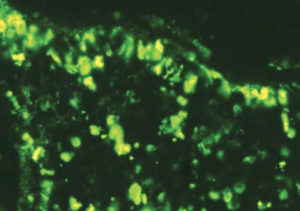Oral inoculation performed in two experiments on juveniles

Several publications have described challenge tests for shrimp viruses using intramuscular inoculation, oral inoculation and immersion. The main purpose of the studies was to learn the pathogenesis of viruses, the influence of different environmental factors or treatments, and the strain comparison in the outcomes of the viral infections.
In most of the studies, the dose of infectious virus given to each animal was unknown primarily due to the lack of available susceptible cell lines for in vitro titration. In some cases, viral quantification by polymerase chain reaction (PCR) has been used to get around this problem.
However, PCR only detects the number of target DNA copies, whether the fragments belong to infectious or noninfectious viral particles. In veterinary medicine, the in vivo titration of viral stocks using the 50 percent endpoint dilution assay is commonly used when virus titers cannot be calculated in vitro.
Study setup
The authors recently conducted a study to determine the shrimp infectious dose 50 percent endpoint (SID50 per milliliter) and lethal dose 50 percent endpoint (LD50 per milliliter) of a White Spot Syndrome Virus (WSSV) isolate by intramuscular and oral inoculation in specific pathogen-free (SPF) Penaeus vannamei.
WSSV stock was obtained by inoculation of a WSSV isolate in the shrimp to amplify the virus. Animals were collected after 48 hours and tissues except the hepatopancreas, gut, and exoskeleton were minced. The supernatant was filtered, divided into aliquots and stored at minus-70 degrees-C. The viral stock was checked by PCR for the absence of other known shrimp viruses.
Test shrimp were kept individually in 10-liter aquariums. For the intramuscular inoculation, two sizes of animals were used: 135- and 60-day-old juveniles. Eight experiments were performed with 245 shrimp. Four to five shrimp were inoculated with a 10-fold serial dilution of the WSSV stock.
The experiments were terminated at 72, 96, 120 and 168 hours. Moribund and dead shrimp were recorded and processed for the detection of WSSV by indirect immunofluorescence (IIF) and one-step PCR.
The in vivo titration by oral inoculation was performed in two experiments on 50, 80-day-old juveniles. The virus titer of the WSSV stock was evaluated using the overall median virus titer after intramuscular inoculation as the basis to define five doses: 103, 102, 101, 10-1 and SID50. This procedure permitted a direct comparison when the inoculum was intramuscular or oral.
Results
The number of viral particles (titers) detected after intramuscular inoculation terminated at the different time points ranged 106.0 to 106.9 SID50 per milliliter. The mortality titers were lower than the infection titers when experiments were terminated at 72 and 96 hours (105.7 and 105.4 LD50 per milliliter, respectively), whereas the mortality titer fully matched the infection titer in the experiments terminated at 120 and 158 hours (106.5 and 106.6 LD50 per milliliter). The same animals were detected positive by immunofluorescence and PCR, suggesting the same sensitivity of these two methods.
The statistical comparison of the different titers by intramuscular inoculation showed no significant differences. Therefore, the six virus titers were used to establish the overall median virus infection titer of the WSSV stock at 106.6 SID50 per milliliter. The overall median virus mortality titer was 106.6 LD50 per milliliter by intramuscular. This indicated the susceptibility to WSSV of juveniles of 60 and 135 days age was the same.
The titers for the WSSV stock by oral route were 105.6 SID50 per milliliter and 105.6 LD50 per milliliter. Once WSSV entered the oral cavities of the shrimp, it had to overcome a series of physical and chemical barriers in the digestive tracts to reach the susceptible epithelial cells. These barriers may have accounted for the reduction of WSSV infection by approximately 1 log10 compared with the intramuscular route of inoculation.
(Editor’s Note: This article was originally published in the December 2005 print edition of the Global Aquaculture Advocate.)
Now that you've finished reading the article ...
… we hope you’ll consider supporting our mission to document the evolution of the global aquaculture industry and share our vast network of contributors’ expansive knowledge every week.
By becoming a Global Seafood Alliance member, you’re ensuring that all of the pre-competitive work we do through member benefits, resources and events can continue. Individual membership costs just $50 a year. GSA individual and corporate members receive complimentary access to a series of GOAL virtual events beginning in April. Join now.
Not a GSA member? Join us.
Author
-
Victoria Alday-Sanz, Ph.D.
INVE Technology NV
Oeverstraat 7
B-9200 Baasrode, Belgium
Tagged With
Related Posts

Health & Welfare
Alphavirus replicon particles potential method for WSSV vaccination of white shrimp
A study demonstrated that VP19 and VP28 white spot syndrome virus envelope proteins expressed by replicon particles provided protection against mortality due to WSSV in shrimp.

Health & Welfare
CENIACUA develops WSSV-resistant shrimp in Colombia
To combat white spot syndrome virus (WSSV) in white shrimp, Corporación Centro de Investigación de la Acuacultura de Colombia (CENIACUA) initiated a selective-breeding program to develop resistance in shrimp.

Health & Welfare
A comprehensive look at the Proficiency Test for farmed shrimp
The University of Arizona Aquaculture Pathology Laboratory has carried out the Proficiency Test (PT) since 2005, with 300-plus diagnostic laboratories participating while improving their capabilities in the diagnosis of several shrimp pathogens.

Responsibility
A look at various intensive shrimp farming systems in Asia
The impact of diseases led some Asian shrimp farming countries to develop biofloc and recirculation aquaculture system (RAS) production technologies. Treating incoming water for culture operations and wastewater treatment are biosecurity measures for disease prevention and control.


